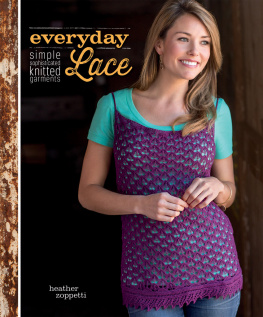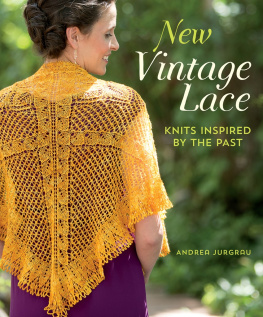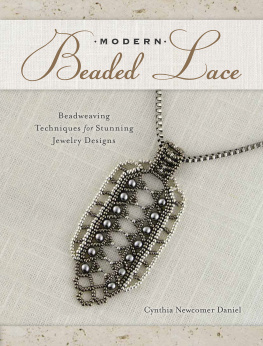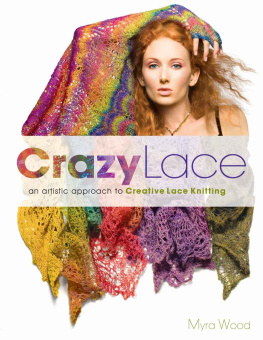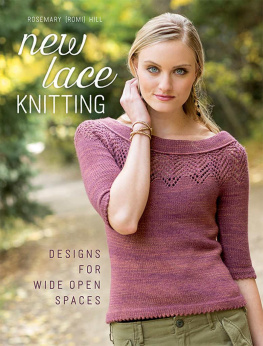I am grateful to the staff (past and present) of Interweave Knits and Knitscene magazines, with particular thanks to Eunny Jang, Lisa Shroyer, Pam Allen, Laura Rintala, Amy Palmer, Kathy Mallo, Nancy Arndt, and Dean Howes, for creating the wonderful magazines from which these patterns and articles are drawn.
Thanks to the rarely sung heroes of knitting patterns, the technical editors, whose work is no less valuable for its near-invisibility. Jeane Hutchins has collected and preserved so much lace knitting in the pages of PieceWork; thanks for sharing your knowledge. Thanks also to Karen Brock for her good humor and hard work throughout the magazine editorial departments. Thanks to the Interweave books department for their tireless efforts, particularly to Julia Boyles for the lovely design and Mary E. KinCannon for her organizational skills and good cheer.
My deepest gratitude goes to the indomitable trio of Ann Budd, Rebecca Campbell, and Kerry Jackson.
Contents
EUNNY JANG
JACKIE ERICKSON-SCHWEITZER
ANN BUDD
KAREN BAUMER
HANA JASON
DONNA DRUCHUNAS
EVELYN A. CLARK
CELESTE CULPEPPER
KATHLEEN POWER JOHNSON
RACHEL ERIN
SUSAN PIERCE LAWRENCE
KAT COYLE
EUNNY JANG
VRONIK AVERY
SARAH SWETT
VRONIK AVERY
FAINA LETOUTCHAIA
CONNIE CHANG CHINCHIO
ANNIE MODESITT
NANCY BUSH
GAYLE ROEHM
EVELYN A. CLARK
EUNNY JANG
SHIRLEY PADEN
ANGELA HAHN
MANDY MOORE
ANNE HANSON
DEBBIE NEW
HANA JASON

There is something uniquely satisfying about knitting lace.
Ive seen lots of metaphors for ita butterfly emerging from a cocoon; a flower bloomingbut to my mind, there is enough romance in the simple reality of lace knitting: execute a few easy, repetitive maneuvers with two sticks, and a length of string transforms into delicate, airy fabric traced with pleasingly intricate patterning. For me, the greatest pleasure of knitted lace is in that sense of transformation, of possibilitytheres a kind of magic to the idea that such simple building blocks can yield such wonderfully rich effects. The most elaborate lace leaves, waves, and flower petals all come from decreases and yarnovers. Richly ornate geometric motifs are the same, just positive and negative space combined in clever ways. Art underlined with solid knitting logic. Amazing!
And thats just the beginning. The great lace knitting traditions of their world all have their own deep, quirky pools of historical interest and technique innovation. Many lace motifs themselves have fascinating, crooked stories behind them. Then theres the question of what can be made entirely of or adorned with knitted lacewraps, of course; garments; and any accessory that can be imagined. The actual business of knitting lace entails its own technical know-how. Knitters make choices about the character of lacebecause lace is such a heavily manipulated fabric, full of yarnover increases and accompanying decreases, the same lace motif will look dramatically different in different gauges and in different fibers. Lace is a world that unfolds with more and deeper rabbit holes the closer you look.
As the editor of Interweave Knits, Ive been lucky enough to work and share ideas with knitting designers who are exploring that complex, faceted worldfrom those steeped in tradition and history to those investigating what lace can do when pushed to its limits. Just as every knitter has her own particular set of factors that go into the projects she chooses, every lace designer has different aims and goals for her designs. Some have clear philosophies expressed in every project: to bring together traditional techniques and modern wardrobes, say. Some want to explore how they can change an established trend with their signature aesthetic. The mathematicians look for new ways to structure lace or otherwise manipulate expectations. The historians want to celebrate lace from a particular place and time. Ultimately, all want to design something that people want to knitluckily, theres a lace knitter for every permutation of motif. project, and material.

Wakame Lace Tunic,

Simply Lovely Lace Socks,

Teardrop Scarves,
In this collection, weve looked for designs that span that full range of possibilities, from modern interpretations of deeply traditional ideas such as Evelyn A. Clarks romantic Paisley Lace Shawl and Nancy Bushs Facing Lilies Stole to lighter fare such as Celeste Culpeppers Teardrop Scarves and Karen Baumers Simply Lovely Lace Socks. Weve got snappy, easy garments such as Vronik Averys sweet Victoria Tanka simple lace stitch, dressed up with fine detailingand Kat Coyles Indigo Ripples Skirt, trimmed in an unfrilly lace stitch and knitted in a denim-dyed cotton. Some garments are more intricate, patterned all over with a delicate stitch (Shirley Padens Oriel Lace Blouse) or a combination of lovely lace panels, carefully arranged (Angela Hahns Wakame Lace Tunic). There are patterns that explore laces starkly graphic possibilities, such as Mandy Moores Dorflinger Tee and Donna Druchunass Arctic Diamonds Stole. There are intricate wraps for romantics, flirty stockings and socks, freshly unfussy tees and hats. The projects span lace traditions from around the world; yarns from cobwebweight alpacas to chunky wools; final effects that range from Victorian elegance to modern punch.
Knitted lace means something different with every project. I hope that as you page through this collection, you feel a sense of discovery and explorationand the urge to knit.
EUNNY JANG
EDITOR, Interweave Knits

JACKIE ERICKSON-SCHWEITZER
all photos by Jackie Erickson-Schweitzer, Interweave Knits, Summer 2006
Airy, light, and a bit mysteriousthe delicate tracery of knitted lace is hard to resist. Even the simplest of lace patterns looks impressive and inspires admiration. But intricate as it may appear, knitted lace is simply a fabric punctuated with deliberate openings that can be arranged in a myriad of ways to create patterns that range from basic to complex. The wonderful thing about knitted lace is that in spite of its apparent intricacy, it follows a simple logic. The openings are created by special increases called yarnovers, and each yarnover is accompanied by a compensating decrease. Once you understand how yarnovers and decreases work together, youll be on your way to mastering the vast array of lace patterns.
Traditional laceweight yarn yields beautiful lace patterns, but sport, worsted, and bulky yarns can be equally effective. A smooth, light-colored fingering or sportweight yarn worked on a needle three to four sizes larger than youd normally use creates a fluid fabric in which the lace pattern is clearly visible. But fuzzy yarns and dark and variegated colors yield impressive results, too. Experiment with different yarns and needle sizes when youre swatching lace patterns to see the variety of effects you can create with a single pattern; youll quickly find out what appeals to you.



